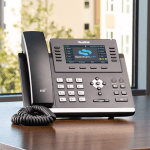Choosing the right office phone system is a crucial decision for any business. It can impact everything from communication efficiency to customer satisfaction. However, with so many options available, it’s easy to make mistakes that could cost time and money. In this blog, we’ll explore common pitfalls in selecting an office phone system and how to steer clear of them.
1. Overlooking Your Business Needs
Every business has unique communication requirements. Not considering your specific needs can lead to choosing a phone system that doesn’t fit well, resulting in poor communication flow and inefficiency. To make an informed choice, start with a thorough assessment of your company’s communication habits and requirements. Consider factors such as the number of employees, expected call volume, and specific features that may enhance productivity. For example, businesses with a high volume of customer service calls might prioritize systems with advanced call routing and analytics capabilities.
It’s also important to think about the integration of your phone system with other business tools. Consider how it will interact with existing software like CRMs, collaboration tools, or customer service platforms. A seamless integration can greatly enhance workflow efficiency and employee satisfaction. Additionally, consider the geographic footprint of your business. If you deal with international clients, look for systems that support international dialing and varying time zones without hefty additional costs.
2. Neglecting Scalability Options
A phone system that can’t grow with your business can become a bottleneck. It’s essential to consider future expansion to avoid frequent system upgrades or replacements. Growth isn’t just about adding more phones; it encompasses the ability to manage increased traffic and evolving business needs. For small businesses anticipating growth, it’s wise to invest in a system that can easily add extensions, lines, and functionalities as needed.
Scalability also ties into flexibility. Are you able to add remote users or branch locations? With the rise of remote work, ensuring that your phone system can adapt to a hybrid model—wherein employees work both remotely and on-site—is crucial. Systems that offer virtual solutions, like VoIP, can be a cost-effective way to maintain flexibility and scalability.
3. Ignoring Compatibility with Existing Systems
Ensure the new system integrates smoothly with your existing technologies. Lack of compatibility can cause disruptions and additional costs for new hardware or software. Integration issues can lead to downtimes or data mismatches that might affect business operations. Therefore, check whether the phone system can seamlessly connect with your existing infrastructure.
Moreover, consider the types of devices and systems currently in use. Do employees favor using mobile devices, or is the business primarily desk-bound? An integrated approach that consolidates various communication channels—mobile, desktop, and conference systems—into a single solution can polish workflow and increase productivity.
4. Underestimating the Importance of Features
Choosing a phone system with inadequately sized feature sets can limit your business capabilities. Consider features like call forwarding, voicemail-to-email, and conferencing to enhance productivity. Advanced features also include automated attendants, call analytics, and integration with cloud services, which can empower your team to function more efficiently and make data-driven decisions.
Think about how specific features might directly impact different departments. For instance, sales teams may benefit from CRM-integrated systems that automatically log calls, while project teams might appreciate video conferencing capabilities. Identifying these requirements helps avoid investing in features that remain unused while ensuring your teams have access to tools they truly need.
5. Failing to Consider User Experience
Complicated systems can lead to frustration and decreased productivity. Opt for user-friendly systems with intuitive interfaces to ensure your team can utilize them effectively. The user interface should be straightforward, allowing employees to perform their tasks without a steep learning curve. Choose a system that offers comprehensive support and training resources to help your team get up to speed.
Additionally, evaluate the mobility of the systems. Can employees easily access features on mobile devices? Is the interface consistent across different devices to minimize confusion? These considerations are particularly important as many businesses now adopt flexible working arrangements, highlighting the need for reliable mobile solutions.
6. Not Evaluating Support Services
Reliable support is crucial for troubleshooting and maintenance. Evaluate the vendor’s customer service options to ensure you’ll have help when needed. Support isn’t just about technical hiccups; it’s about having timely assistance. Check whether customer support is accessible 24⁄7 and if they offer multiple contact methods, such as phone, email, or live chat.
Review customer testimonials or case studies to gauge the vendor’s track record in resolving issues efficiently. Knowing you have a responsive support team can give peace of mind and minimize downtime, keeping your business running smoothly.
7. Disregarding Security Measures
Security should be a priority to protect sensitive business information. Ensure the phone system has robust security protocols to prevent unauthorized access and data breaches. Look for encryption standards that ensure your data is secure even during transmission. Additionally, features like multi-factor authentication can add an extra layer of protection against unauthorized access.
It’s also vital to consider compliance with industry-specific regulations, such as HIPAA for healthcare or GDPR for international clientele. A secure communication system will not only protect your data but also uphold your reputation as a trusted business partner.
8. Overlooking Cost Transparency
Hidden costs can quickly inflate your budget. Seek clarity on all costs involved, including setup fees, monthly expenses, and potential additional charges. Transparent pricing is crucial for accurate budgeting and financial planning. Request detailed quotes that outline both immediate and long-term costs.
Consider whether the pricing model aligns with your usage patterns. For some companies, a pay-as-you-go model might be more cost-effective than a flat-rate plan. Weighing these options can help avoid surprises and ensure you’re not overpaying for unused features. Visit our pricing page to explore options that best suit your budget needs.
9. Neglecting to Test the System
A trial run can reveal unforeseen issues with a phone system. Always test a system before committing to ensure it meets your business requirements and expectations. Testing will help identify any operational glitches, ensuring the system performs well under real-world conditions.
Organize a pilot test with a small group of users across different departments. Encourage detailed feedback on system functionality, user experience, and integration levels. This feedback will provide valuable insights and prevent costly last-minute changes during a full-scale rollout.




